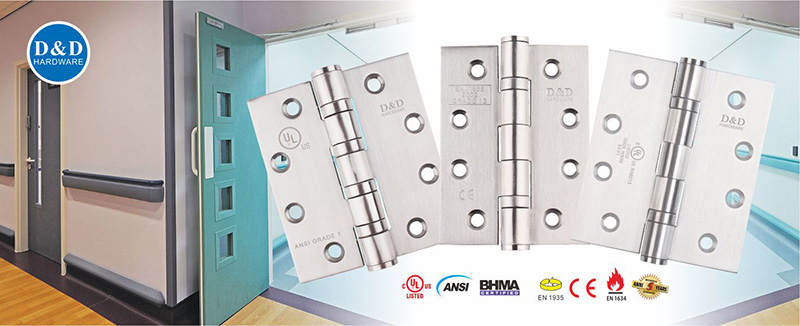Views: 0 Author: D&D Hardware Publish Time: 2020-11-12 Origin: D&D Hardware

Door hardware is an important part of the door, in the design and calculation of door hardware selection, hinge as a load-bearing component, has an important position. The bearing capacity of hinge affects the safety performance and service life of the whole door.
These door and frame factors influence hinge selection:
Door and frame material
Frequency of use Environment
Door weight
Door width
Door control hardware
Labeling requirements
Projecting trim
Location of opening
Select the proper weight and bearing structure
Because of the large variety of door size and weights, hinges are placed into three groups:
Heavy weight – Ball bearing
Standard weight – Ball bearing
Standard weight – Plain bearing
There are two factors that determine the weight and structure of the hinge, mainly weight of door and frequency of use.
The weight of the door is based strictly on how much the material of the door weighs. It also is advisable to include the approximate weight of additional hardware that will be installed on the door.
Use below table for estimating the door weight because other factors, such as installed hardware, also affect the total weight of the door.

The next factor is the frequency of use. How often is the door opened and closed in a given time frame? This usually is figured on a daily basis.
Below table lists the expected frequency of operation of various types of openings.

These frequency chart recommendations apply to all average weight doors, Heavy ball bearing hinges should be used for larger doors (i.e. doors having a thickness of 2” or more and over a width of 3’4”.)
Another critical note which often is neglected relates to doors on which a closing devise is used. These doors should be equipped with ball bearing hinges, regardless of frequency of use.
Determine the size of hinge:
In order to determine the proper size of the hinge, several bits of information will be necessary:
Door Height Door Width Door thickness Door Weight Trim Dimension Required
Below table lists the hinge sizes recommended for various size doors:

Heavy weight hinges should be specified for heavy doors and for doors which are expected to receive high frequency use.
Determine the width of hinge:
Using hinges that are wider than needed results in poor appearance because the hinges will be unnecessarily prominent. For the sake of appearances, never select hinges wider than necessary to clear the trim.
Manufacturers publish a formula for correctly determining the width of full mortise hinges. Full mortise hinges are available in several standard widths. Choose the next closest width to satisfy the opening conditions.
![]()
Note: Hinge back-set for 1-3/8”, 1-3/4” and 2-1/4” thick doors is 1/4”. For doors more than 2-1/4” thick, the hinge back-set is 3/8”. Confirm hinge back-set dimension with door manufacturer.
This formula would apply only to full mortise hinges.

Determine the quantity of hinge:
In our industry there is a rule used to determine the number of hinges needed per door: one hinge for every 30” of door height or fraction thereof.

The intermediate hinge(s) help to carry the weight of the door and keep the door properly aligned in the frame, increasing the life span of the entire opening.
Common Causes of Hinge Failure:

Door hardware is an important part of the door, in the design and calculation of door hardware selection, hinge as a load-bearing component, has an important position. The bearing capacity of hinge affects the safety performance and service life of the whole door. D & D hardware can provide detailed and professional hardware matching scheme according to different situations. Professional service and high-quality products can make customers more assured and save costs.
For further information about door hinge or any of our services, click here.
Contact us Now:
Contact: David Jian
Mob: 0086-139 2903 7292
Email: David@dndhardware.com, sales@dndhardware.com
Jobby Zhang
Mob: 0086-137 2599 9617
Email: jobby@dndhardware.com